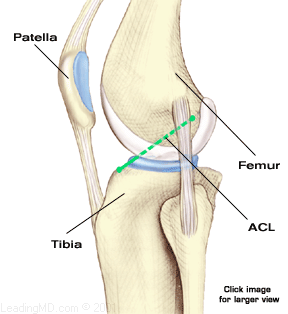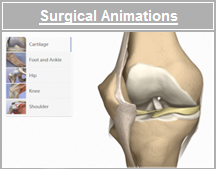
|
ACL Injuries 
What does the ACL do?
The ACL is also very susceptible to injury in contact sports. It can be damaged along with the medial collateral ligament (MCL) when the knee is struck from the outside. A hit that results in the tibia being driven forward, the femur being driven backward, or the knee joint being severely hyperextended may result in damage to the ACL. Females appear to be more at risk for ACL injuries. Competitive female soccer and basketball players have 3-5 times higher risk of ACL injury than their male counterparts. Why do females seem more likely to injure the ACL when they play the same sports as males? Many studies are looking at the physical differences between the sexes for answers to this question. Two differences are size and strength. The ACL and the notch (illustration) on the femur that it sits in are smaller in women than in men, but that may just be because women are smaller than men. The male's lower percentage of body fat and greater muscle mass give the male an advantage in muscular strength to protect the ACL. Other differences make the female a more likely candidate for ACL trouble than her male counterpart. The mechanics of the woman's body, with the pelvis creating a larger angle from hip to knee, may make the knee more prone to injury. Neuromuscular differences in the timing of muscle activation and how women perform risky movements may increase the female's vulnerability to ACL injury. Women tend to change direction and land from jumps in a more erect stance, and this can put the ACL under strain. Hormonal differences focus on estrogen in the female body and its effect on ligament laxity and knee looseness. Although these theories have not been proven, agility training and muscle strengthening seem to be appropriate measures women can take to help prevent injury. © 2016 by LeadingMD.com All rights reserved. |







